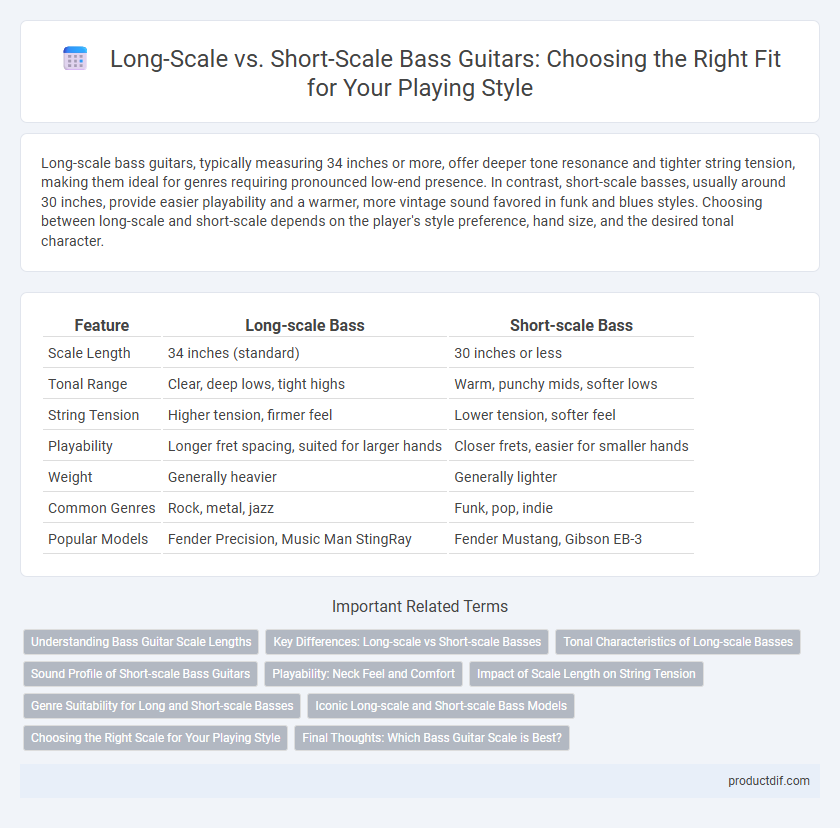Long-scale bass guitars, typically measuring 34 inches or more, offer deeper tone resonance and tighter string tension, making them ideal for genres requiring pronounced low-end presence. In contrast, short-scale basses, usually around 30 inches, provide easier playability and a warmer, more vintage sound favored in funk and blues styles. Choosing between long-scale and short-scale depends on the player's style preference, hand size, and the desired tonal character.
Table of Comparison
| Feature | Long-scale Bass | Short-scale Bass |
|---|---|---|
| Scale Length | 34 inches (standard) | 30 inches or less |
| Tonal Range | Clear, deep lows, tight highs | Warm, punchy mids, softer lows |
| String Tension | Higher tension, firmer feel | Lower tension, softer feel |
| Playability | Longer fret spacing, suited for larger hands | Closer frets, easier for smaller hands |
| Weight | Generally heavier | Generally lighter |
| Common Genres | Rock, metal, jazz | Funk, pop, indie |
| Popular Models | Fender Precision, Music Man StingRay | Fender Mustang, Gibson EB-3 |
Understanding Bass Guitar Scale Lengths
Bass guitar scale length, typically measured from the nut to the bridge saddle, directly influences string tension, tone, and playability. Long-scale basses, usually around 34 inches, offer tighter string tension and deeper, more defined low-end frequencies favored in genres like rock and metal. Short-scale basses, generally 30 inches or less, provide easier playability and a warmer, rounder tone, making them ideal for jazz and vintage styles.
Key Differences: Long-scale vs Short-scale Basses
Long-scale bass guitars typically have a scale length of 34 inches, providing tighter string tension, deeper tone, and greater sustain, ideal for traditional rock and metal genres. Short-scale basses, usually with a 30-inch scale length, offer easier playability, warmer sound, and faster string response, favored by jazz, funk, and pop musicians. The difference in scale length affects string gauge, fret spacing, and overall tonal characteristics, shaping the player's choice based on comfort and desired sound.
Tonal Characteristics of Long-scale Basses
Long-scale bass guitars, typically featuring a 34-inch or longer scale length, deliver tighter string tension that enhances note clarity and sustain, producing a bright and punchy tonal profile. This extended scale favors well-defined low frequencies and harmonics, allowing for precise articulation across various playing styles. Players seeking a robust, full-bodied sound with pronounced attack often prefer long-scale basses for genres like rock, funk, and jazz.
Sound Profile of Short-scale Bass Guitars
Short-scale bass guitars typically produce a warmer, fuller tone with enhanced midrange frequencies and a softer attack compared to long-scale models. Their shorter scale length, usually around 30 inches or less, results in looser string tension, contributing to a rounder, more vintage sound profile favored in genres like funk, jazz, and indie rock. These instruments excel in delivering smooth, thick fundamental notes, making them ideal for players seeking a distinctive, mellow bass voice.
Playability: Neck Feel and Comfort
Long-scale bass guitars typically have a scale length of 34 inches, offering tighter string tension and a more defined tone, which can enhance playability for musicians seeking precision and clarity. Short-scale bass guitars, commonly around 30 inches, feature reduced string tension and a smaller neck profile, resulting in increased comfort and easier playability, especially for players with smaller hands. The choice between long-scale and short-scale necks significantly impacts neck feel and overall comfort, influencing playing style and endurance during extended sessions.
Impact of Scale Length on String Tension
Long-scale bass guitars, typically around 34 inches, produce higher string tension, resulting in a tighter feel and clearer note definition, especially beneficial for genres requiring precise articulation. Short-scale basses, usually about 30 inches, have lower string tension, offering easier playability and a warmer, more mellow tone that suits vintage or jazz styles. String tension directly affects playability, tonal clarity, and sustain, making scale length a crucial factor in selecting the right bass guitar for specific musical demands.
Genre Suitability for Long and Short-scale Basses
Long-scale bass guitars, typically measuring 34 inches, deliver tighter string tension and more defined low-end frequencies, making them ideal for genres such as rock, metal, and funk where clarity and punch are essential. Short-scale basses, often around 30 inches in length, provide a warmer, rounder tone with easier playability, favored in jazz, blues, and pop for their smooth, mellow sound and enhanced expressiveness. Musicians select scale length to match their genre-specific tonal needs and playing style preferences, balancing string tension and tonal character accordingly.
Iconic Long-scale and Short-scale Bass Models
Iconic long-scale bass models like the Fender Precision Bass and Jazz Bass feature a 34-inch scale length, delivering a deep, punchy tone with enhanced string tension ideal for versatile genres. Short-scale basses, such as the Hofner 500/1 and the Danelectro Longhorn, typically have a 30-inch scale length, providing a warmer, mellower sound favored in vintage rock and Motown styles. These scale variations significantly impact playability, tone, and string tension, influencing bassists' choice depending on the musical context.
Choosing the Right Scale for Your Playing Style
Long-scale bass guitars, typically with a 34-inch scale length, offer greater string tension and clearer note definition, ideal for genres requiring tight, punchy tones like rock and metal. Short-scale basses, usually around 30 inches, provide easier playability and a warmer, rounder sound, favored by jazz and funk players who prioritize comfort and fluid finger movement. Choosing the right scale length depends on balancing desired tonal characteristics with hand size and playing technique.
Final Thoughts: Which Bass Guitar Scale is Best?
Choosing between long-scale and short-scale bass guitars depends on playing style and tonal preferences, with long-scale basses offering tighter string tension and clearer low-end frequencies ideal for rock and metal genres. Short-scale basses provide easier playability and a warmer, more rounded tone favored in jazz, funk, and blues. Evaluating string tension, tonal clarity, and ergonomic comfort is essential to determine the best bass guitar scale for individual musicians.
Long-scale vs Short-scale (bass guitars) Infographic

 productdif.com
productdif.com